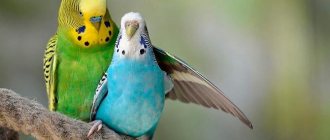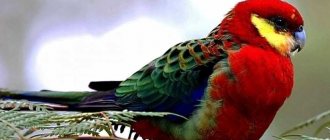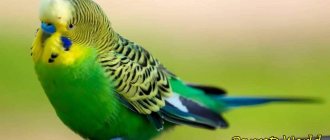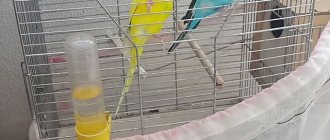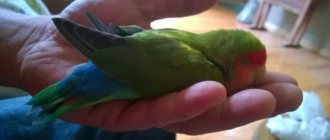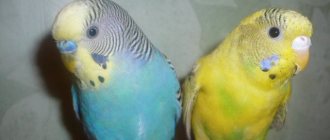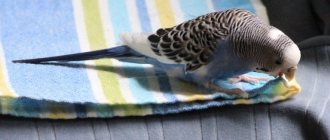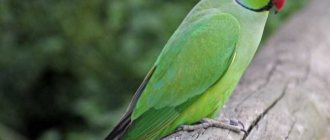The first meeting of a person with this bright small bird, also called a penant, took place near Sydney, in the Rose Hill colony. The name of the area prompted us to give the bird such a beautiful and unusual name. The appearance of the red rosella parrot really makes one think of flowering plants. Bright red plumage adorns the bird's head and chest, a small blue spot on the chin, a blue-black tail, and the wings are equipped with a scaly pattern combining shades of red and black. Because of its colorful appearance and peaceful nature, the red rosella has become a favorite of parrot breeders.
Varieties
The most popular types:
- Green. Their shoulder and back areas are gray-green or green and yellow; wings green or black with blue tips; the chest and neck, as well as the parietal part, are green and yellow; on the forehead there is a predominance of red; cheeks blue.
- Pale-headed. The color of the shoulders and back is yellow with black spots; the head is pale lemon in color; chest and belly blue; wings blue-black; the tail is the same color as the wings; there is a red spot on the inside.
- Blackhead. The color of the head and neck from the back is black; back black with pale yellow; the cheeks are white, the neck area under them is blue; chest pale yellow; the tail is blue and black, the undertail is red.
- Yellow-cheeked. A characteristic feature is the cheeks are yellow, the head, neck, chest and undertail are red; the wings are colored in shades of black, blue, green and yellow.
- Red. The main color of the plumage is red, the cheeks, tail and part of the wings are bright blue. The main color of the wings is black.
Description and intelligence of a parrot
The parrot called rosella looks very interesting: it has “scaly” plumage on the back and wings, somewhat reminiscent of the color of a budgerigar. The central part of each feather is black, and the edging is colored: red, yellow, blue (depending on the subspecies of the bird). There are spots on the cheeks that are blue, white or yellow. The tail is long, stepped. The wings, folded on the back, reach the middle of the tail feathers. The size of the parrot does not exceed 35 cm, including a 15 cm tail.
The general impression of the bird is that it is plump and stocky, but its body weight is only 70-100 g. The bird's beak is small, neat, with a sharp tip.
Rosella can repeat words, but is difficult to train - the most capable individuals have a vocabulary of less than 10 expressions. The parrot has low intelligence, but it has certain talents: the ability to imitate, the ability to sing. A soft, flexible character and innate empathy are the obvious advantages of Rosella.
Notice! The bird senses a person’s mood well, but natural caution slows down the taming process. To establish emotional contact, you will have to spend a lot of time with your pet.
Varieties
The current classification contains 6 species of Rosella parrots, differing in the color scheme of their plumage:
- Motley. She has a red head and white cheeks, a yellow chest, and a greenish belly. The black feathers on the wings are framed with a yellow-green border, the edges of the wings are blue, the tail is blue-green with a red underside.
Variegated rosella - Red. The body is completely red, with the exception of the area under the beak - there is a blue “beard”. The wings are black with red edging, the tail and shoulders are blue.
Red rosella - Green. Body color is yellow with a greenish tint. Dark green feathers, diluted with blue splashes, grow from the back of the head along the back and wings. There is a red spot on the forehead. The tail is brown in the center, blue at the edges, and gray on the underside.
Green rosella - Yellow-cheeked. The smallest rosella (measuring only 28 cm) looks the same as the pied one, but its cheeks are yellow. Moreover, the feathers on the wings are not yellow, but green-blue. The back is green.
Yellow-cheeked rosella - Pale-headed. The color of this bird is dominated by blue and yellow shades. The head is light yellow, the facial mask is white, the back of the neck is lemon-colored, and the back is black and yellow. From the breast to the legs there are bluish feathers, the undertail is red. The sides of the wings are blue, the central feathers are mottled.
Pale-headed rosella - Black-headed. The feathers have a black and white pattern. The head is black, the cheeks are white, and there is a blue stripe on the throat. On the front of the body there are milky feathers with a black scaly pattern, merging into a red triangle under the tail. The shoulders and tail are blue.
Black-headed rosella
Did you know? In addition to natural colors, there are hybrid ones: for example, lutino, hyacinth. All males have a more impressive build and brighter colors than females.
How to choose the right one and how much it costs
You should purchase birds from breeders who keep their animals in appropriate conditions, otherwise you risk purchasing a sick pet with a quarrelsome character. The best age to purchase is a parrot that is five or six weeks old; an older bird will be more difficult to tame.
Signs of a healthy bird:
- clean, growth-free paws and beak;
- shiny clean feathers without bald spots;
- clean mucous membrane of the eyes without discharge;
- anal area without redness or suspicious formations;
- the chick should be active, chirping and mobile.
Depression, lethargy, cloudy eyes and drooping wings are a sign of the disease. How much a Rosella parrot costs largely depends on the availability of a health certificate; in general, the price for chicks ranges from $80 to $170 .
The nursery worker will provide you with information about the parents, diet and conditions most suitable for the bird. In addition, in a specialized institution you can obtain a document confirming the health of the bird :
- results of helminthological research;
- results of bacteriological examination;
- biochemical blood test (this analysis can be used to indirectly judge the condition of the liver, kidneys, and heart);
- analysis for chlamydia (ornithosis, psittacosis).
Owner reviews
Despite all the difficulties in caring for rosella, a parrot can become a real decoration for any home. It must be taken into account that even if kept for many years, this bird will not become completely tame. Contacts with the outside world are rather painful for her. If a bird hears an extraneous, unfamiliar voice, it tries to look at the speaker, turning its head to the sides. Some say that even when household members appear in atypical clothes, Rosella will freeze and wait for the consequences of the unusual situation.
She will not sing too often, mainly when there is no one else in the room. Intense screams gradually emerge from the melodic singing.
Important: this type of parrot chews everything. This must be taken into account when choosing cages, toys, and any accessories. Sometimes Rosella will “deal” with an unruly object for several days in a row until she bites it off.
For information on taming the Rosella parrot, watch the following video.
How to determine age, differences between females and males
Another argument for purchasing a bird from a nursery is that they will tell you its age. The fact is that only a specialist can often determine it. There are several tips on how to determine the age of a rosella , although very approximate:
- In young birds (immature) the skin on the legs is very thin and smooth, it becomes rougher with age; in old parrots it is wrinkled and rough.
- Birds reach sexual maturity in the second year of life, at which time they “change” into adult plumage.
It is also difficult to distinguish males from females. The main difference in all birds is the brightness of the plumage, but in rosellas this feature can be smoothed out. In general, experts advise taking a closer look at the color of the cheeks: in females it is paler, in males it is snow-white or bright (depending on the species). When comparing two individuals, the male has a larger head and beak. In some varieties, the female develops a white stripe on the wing, in the lower part, by the age of one year.
Sex determination in cockatiels
The sex of these beautiful birds can be determined in several stages. But the most reliable way to recognize a male or female is closer to the year.
Before this age, you can also try to determine the sex of the parrot in the following ways :
- The first method is relevant after about 3.5 months of a parrot’s life. At this age, males begin to demonstrate their vocal abilities. This continues for the next three months. The females remain indifferent and sit quietly on the sidelines.
- To use the second method, you need to wait for the molt. It occurs at the age of 6-8 months. After the change of plumage, the males become somewhat brighter than the females. The latter acquire more rounded shapes and a calm disposition.
Already at an older age, after 1 year, the gender identity of Cockatiels is most pronounced. So the males become pearl-gray in color, the “cheeks” acquire a red-orange hue. At the same time, females have dusty gray plumage with a possible brown tint. And their “blush” is not so noticeable.
As for the yellow cockatiels (Lutino), the definition is a little more complicated. In females, unlike the opposite sex, on the inside of the wings you can see spots slightly darker than the color of the main plumage. Also at the bottom of the tail, the transverse line has a more saturated shade of yellow.
Conditions of detention
The cage with the pet should not be close to the window; too bright lighting is not suitable for them. Dampness, drafts and cold are not favorable for birds. Optimal conditions:
- humidity - 50-60%;
- temperature - 20-22 °C.
The room must be constantly ventilated, access to fresh air is the key to the health of the birds. Feathered creatures must be able to spread their wings; birds growing up in captivity and not being able to fly may refuse to mate, this will also affect their psychological state.
Once a month, you need to disinfect the place where your pet is kept (cage) with special equipment, and then be sure to rinse it with running water. Once a week, wash feeders and drinkers, toys and other items in the cage. Every day you need to remove food that has fallen from the feeder and clean the bedding layer.
Breeding Features
A nesting house measuring 0.25x0.25x0.4 m is built for birds in the spring. Peat and sawdust are poured inside. This is the most favorable basis for hatching. Important: birds can build their own nest. There would be material for such construction.
To regulate the reproduction of parrots, you can deliberately deprive them of the opportunity to build a nest. But even with strict adherence to the basic rules, you may not wait for the chicks to appear. The main reasons for their death are:
- oxygen deficiency;
- low humidity;
- clogging of the shell surface.
Rosella leaves the nest during incubation only to eat. Food and water should be placed closer to the bird. The hatched chicks are blind, but already have thick down. Feeding actually falls on the owners. Rosella will be able to feed on its own only at one month of age.
The air temperature when keeping rosellas should be kept at around 20-25 degrees. It is necessary to take care of a constant flow of fresh air. Daylight hours should be at least 18 hours. In winter, the lack of light is compensated artificially.
Important: when giving the bird the opportunity to fly around the apartment, you must close all the windows to prevent escape.
How to choose a home for a parrot
The “house” for the bird should be spacious and comfortable, it should feel comfortable there, in addition, the material from which it is made should be safe and not have any pungent chemical odors.
Dimensions and shape
The pet's cage should be spacious, for example, 150x70x70 cm, the shape is better rectangular or square. A round cage may have an aesthetic appearance, but when frightened, the bird tends to hide in a corner, not finding such shelter, the parrot will get stressed. Be sure to find out what materials the cage bars are made of.
Cages made of wood are not advisable, since parrots will quickly render them unusable by gnawing the wood, and besides, the wood can harbor parasites and bacteria. It is advisable to have a high tray.
Arrangement of the cage
The following items should be placed in the bird's home:
- perch (one or several pieces);
- feeders;
- drinking bowls;
- toys (mirror, swing);
- swimsuit
Rosellas love water treatments and enjoy splashing in the water; provide them with a bathing suit (a container with a suitable depth). To prevent your pet from getting bored, prepare ladders, perches, toys and arrange them so that they do not clutter up the space. It is better to hang drinking bowls and feeders on the walls of the cage; food should not be on the floor. It is better to cover the bottom with calcined sand, and place several strong pieces of wood to sharpen the beak and claws.
Sex determination in large parrots
The most particular difficulty is determining the sex of medium and large parrots such as Jaco, Macaw, Cockatoo, etc. Females and males of these species look almost the same. Therefore, for a more accurate determination, it is necessary to compare several of their representatives at once.
Several characteristic features can be identified:
- Females of large parrots have a wider pelvis than males. This also causes the paws to be positioned when stepping on the perch. They take steps slightly wider than males.
- The head of females is more neat and compact than that of males.
- The beak of males is more massive.
It should also be noted that males are considered more “talkative” and active. And females are usually recognized by their “housekeeping.” They can quite often carry scraps of paper, feathers, and some sticks in their beak for nest building.
But all these signs are very relative. Sometimes the difference between the sexes can only be determined when the parrots reach sexual maturity. And in an earlier period it is not possible to do this. But if you love your pet and know about all its habits, then you hold the cards. You can determine the gender of your pet without much difficulty.
Feeding and caring for your feathered friend
Let's figure out what to feed rosella. They buy grain mixtures for pets and give them vegetables and fruits daily, which are a source of fiber, minerals and vitamins.
They can be given almost all vegetables and fruits, berries:
- apple and pear, currants, blackberries, cherries and cherries, bananas, strawberries and raspberries;
- carrots, cabbage, spinach, corn, peppers, cucumbers, greens, radishes.
You can give dried fruits by pre-soaking them. Citrus fruits should be given without the peel: it contains a lot of essential oils that are undesirable for birds.
In addition to dry grain food, birds benefit from porridge and cottage cheese, boiled eggs and homemade cheese without hot spices; you can occasionally give them cookies.
You should not eat too fatty foods, sausages, fried and smoked meat and fish products, sweets, alcohol and decoctions of diuretic herbs.
To determine your pet's normal, observe him. There should be no more food in the feeder than he eats in a day.
Why parrots are special:
Lifespan
On average, pets delight people from fifteen to twenty years, but there are long-lived individuals whose life will last up to thirty-five.
Intellectual abilities and skills
Everyone, without exception, loves music and easily repeats melodies, whistling them cleanly and rhythmically.
Rosella's skills and intellectual abilities
Breeders tell a lot of interesting things about rosellas. They:
- Excellent imitators, they imitate dogs, cats, humans, and accurately convey the creaking of doors and other sounds.
- They love communication and get used to their owner faster than others.
- They get along with everyone, except parrots of another species, with which they usually share territory, and conflict.
- They move quickly on the surface, fly short distances - a few strokes before the next landing.
- Music is closer to them because their voice is close to flute sounds, gentle, but the bass is not so easy to come by.
- They whistle and chirp.
- Chicks, accustomed to humans, learn quickly.
Education and training
Before training a rosella, the bird needs to be tamed; we’ll look at how to do this below. Taming begins from the first days of a bird’s life in your home: the cage needs to be positioned approximately at the level of its height, so that you are visually on the same line when communicating, which is already positioned. You must immediately give the bird a name and address it exclusively by name. To earn trust, you need to communicate in an even and calm tone; when talking to your pet, it is not advisable to make sudden movements. Approach the cage, and when the bird is not busy with anything, and when it is eating or cleaning its feathers, it will quickly get used to your presence.
Second stage: take some food in your palm and offer it to the bird by sticking your hand into the cage. Do not expect immediate results; your pet may be wary for several days. Repeat your actions, and a little trick will help you achieve faster success: a hungry bird will quickly take food from your hand.
The third stage of training: carry the rosella out of the cage on your hand. Here you will also need patience, but the parrot already trusts you and is unlikely to resist innovations for long. Teaching a bird to speak is not as easy as teaching it to use its hands, but it is also quite possible. The best hours for lessons are morning or evening. The foundations of learning are laid already when you start talking to your pet: the more often you talk, the faster he will remember the most repeated words from your speech. When the “lesson” is going on, the room should be quiet, no distracting sounds (TV, radio). Encourage successful attempts to repeat the word with something tasty - this is a good incentive. You can leave your pet a tape recording of spoken language, but you need to take into account that the parrot will repeat everything it hears, including extraneous noises, so the recording should be of the highest quality.
Character and abilities
Both adults and juveniles of the species are trainable. They can be trained to perform simple tricks, imitate sounds and repeat a small number of words. However, this will require a lot of time and patience. It cannot be said that the penant rosella parrot grasps new information on the fly, but it is not worth enrolling it in incapable students.
These birds are best at onomatopoeia. They whistle the melodies they hear and often dance to the “music” they perform. Sluggish movements and stamping on the spot look somewhat ridiculous, but they bring a lot of pleasure to the birds. Thanks to these musical characteristics of birds, the breeding of penant rosella is becoming more and more popular.
The calm nature of parrots of this species is surprisingly harmoniously combined with their incredible activity. Bright birds move a lot and constantly find something to do, they do not have the habit of making noise and annoying their owner with annoying screams. Since caring for and maintaining a Rosella parrot does not require much effort, both a novice breeder and a child can become their owner. Birds are friendly and happy to interact with humans, making them excellent pets for extroverts.
Despite its peacefulness towards people, the red-capped rosella (as penant birds are sometimes called), often shows aggression towards other birds. The victims tend to be smaller birds with similar personalities. However, scientists also know exceptions: some parrots of the species find contact with other birds.
The main thing in the care and maintenance of Rosella parrots is love and attention. Like any living creature that communicates with a person, a bird feels when negative and positive emotions are shown towards it. If the owner devotes time to the pet, takes care of it and does not offend it, the bird will become its faithful friend.
Possible diseases and how long they live at home
The most exciting question for the future owner of a Rosella parrot is how long the bird lives. With good care, feathered pets can live up to 25 years; diseases can shorten their lives; the most common in this breed are intestinal diseases and stress. In addition to them, a feathered pet may have the following ailments :
- smallpox;
- pasteurellosis;
- mycoplasmosis;
- psittacosis;
- tuberculosis;
- aspergillotoxicosis;
- goiter inflammation.
The most common causes of disease are an improperly balanced diet , namely:
- lack of vitamins and minerals;
- failure to comply with hygiene and disinfection rules;
- poor living conditions: low temperature, draft, dry or too humid air.
The doctor, after conducting research and tests, will be able to establish an accurate diagnosis and prescribe treatment.
The following signs may indicate the disease:
- a sick bird stops grooming itself, bathing, and cleaning its feathers;
- sits indifferently, ruffled;
- often trembles all over;
- closes his eyes;
- loses appetite, drinks a lot or does not drink water at all.
Disease Prevention
Despite the resistance of the body in general and the immune system in particular, rosellas can still get sick. The main danger is stress. If a bird is exposed to it, then the threat of manifestation of the pathogenic properties of any microorganism is very high. If injuries occur due to stress, treatment is impossible in principle. The only way to fight is to maintain optimal peace.
You can exclude infection with respiratory mycoplasmosis if:
- systematically clean the cage;
- give only clean water;
- take care of the quality of feed;
- periodically treat the cage with quicklime.
Rosellas delivered from European countries are often infected with circovirus. In the EU, veterinary control is much stricter when importing animals, so illicit goods are systematically “dumped” into our country. Due to the disease, the bird's plumage is disrupted and the shape of the beak is distorted. To make matters worse, the bird’s immunity and nervous tissue suffer.
When purchasing, you must carefully find out the country of origin of rosella. It is also useful to inquire about the sanitary accompanying documents. You can reduce the risk of infection by:
- carefully remove scales and droppings;
- give only proven, high quality food;
- prevent contact between sick and healthy birds.
Since Rosella is curious and very mobile, she can be seriously injured. There are no ways to prevent injuries. Only an ornithologist-veterinarian can provide assistance. Methods for preventing vitamin deficiencies and parasitic diseases are the same as for other parrots. Periodic veterinary examinations are strongly recommended.
Maintaining normal living conditions for poultry is possible thanks to air humidifiers and ionizers. To strengthen the body of rosella parrots, ordinary vitamin preparations are used. They must be stored in the refrigerator. In order to start treatment in a timely manner, you need to carefully monitor the changing behavior of rosella.
To prevent intoxication, it is necessary to remove parrots from the room during any painting and disinfection, during deratization, during repairs and cleaning using toxic substances. Rosella can be poisoned by a wide variety of house and garden plants. Therefore, it is necessary to keep the parrot away from all vegetation that is not known to be safe for this species.
The biggest threat is yew, datura, acacia and golden shower.
Wild datura, henbane, nightshade, belladonna and black crow are also toxic. Among indoor crops, it is advised to beware of:
- oleander;
- periwinkle;
- raven eye;
- any type of Dieffenbachia.
Reproduction in captivity
Rosellas naturally nest twice a year and reach sexual maturity at 15-18 months. To begin with, the selected pair should be provided with a nesting area: a house measuring approximately 30x30x45 cm, with sawdust laid on the bottom. It is necessary to prepare grass and leaves, thin flexible twigs for the female to build a nest. Many parrot breeding experts argue that depriving a female of the opportunity to build a nest can suppress her reproductive system over time. The pair's mating period occurs at the beginning of spring; the male touchingly cares for his chosen one, cleans her feathers, and offers her food.
After mating, the female lays up to five eggs, which she incubates for about three weeks. All this time, water and food should be nearby. At the first laying, failure is possible: the eggs will not be fertilized. How to figure this out? “Living” eggs will be a grayish-white matte color, and in the light dark stripes will be visible through the shell - the vessels of the future chick. Unfertilized eggs will be yellowish in color, with a shiny, often spotted shell. If, upon inspection, all the eggs are not fertilized, do not remove them before three weeks, so as not to injure the female.
Penantha rosella: breeding and raising chicks
To obtain offspring, you need to find a suitable pair for the parrot. In nature, birds choose partners from representatives of the species that are part of their flock. Having reached 2 years of age, they begin to look for a life partner. Courtship peaks during the mating season, which occurs in March or April. At this time, female penant rosellas literally bask in the attention of males: the latter not only attract the ladies with sounds and characteristic dances, but also feed them, help clean their plumage and protect them from enemies. After mating, from 4 to 6 eggs appear in the clutch, which the female incubates. For about three weeks, the expectant mother takes care of the unborn parrots, and the male takes care of her in every possible way.
Breeding penant rosella does not require much effort from the breeder. All that is needed for the birth of offspring is a suitable nest for the birds, regular access to food and water. If the fertilization process of eggs does not deviate from the norm, the chicks are born after 22-24 days. Blind and covered with thick down, the birds are absolutely dependent for the first month, so caring for them falls on the wings of their parents. The red rosella is a species of parrot that has a strong love for and attachment to its offspring. Therefore, the birds, even after the chicks grow up, learn to fly and become more independent, continue to help them and look after them.
If breeding penant rosella interests you as an additional income, you should understand that not all eggs laid by parrots hatch into chicks. It happens that the eggs turn out to be unfertilized and then mating and further laying occur again. There are also cases where females ate laid eggs. Scientists explain this violation by a lack of calcium in the body of a mature individual.
Determining the age of rosella
When purchasing a bird, a breeder is usually interested in its health status, gender and age. Its viability and procreation depend on whether the bird has any diseases. If your parrot has a weakened immune system or a non-dangerous illness, it may die if left untreated. Knowing the sex of the bird is important for those who plan to breed these Australian birds or get a pair so that the birds do not get bored. But absolutely everyone needs to check the age of the rosella when purchasing.
Why? Unscrupulous sellers try to sell old birds. Many of them are no longer able to reproduce and maintain their former vigor. The older the bird, the higher the likelihood that it will be weak and sick. Especially if he was not properly cared for and his diet was incorrect. We will tell you in this article how to determine the age of a Rosella parrot and not become deceived by pet buyers.
The most accurate method is DNA analysis
The DNA test guarantees the accuracy of the research. With its help, the probability of distinguishing the gender of budgerigars is very high. Feathers, blood, and egg shells are suitable for analysis. In terms of the reliability of the result, blood and feathers are identical, but the shell is only suitable if the inner membrane is preserved.
Tips for collecting feather material:
- the fallen feather is not used for dough; healthy, medium-sized feathers are plucked out;
- the fluff from under the wings is not suitable;
- The tip of the pen should be white.
Important: if there are drops of blood left on the feathers, they should not be washed off. Such material is suitable for analysis.
Instructions for taking blood samples:
- the device for cutting nails is sterilized;
- wipe the claws with alcohol;
- The cutting site is chosen at the tip of the claw, where the vessel passes.
After the manipulations, the material is sent to the laboratory.
DNA testing is expensive, exceeding the price of the bird itself. This method is rarely used, mainly if it is important to determine the sex of parrots. It is not advisable to order a DNA testing procedure just out of curiosity.
It is more difficult to tame an adult bird than a young one. If you need a feathered pet to teach it to imitate human speech, choose a male at the age of three to four months. Now you have complete information on how to determine the sex of a budgie.
Calculating age by appearance
How old a parrot is can only be accurately determined through special research. To do this, the bird is taken to a veterinary clinic, where samples of its blood and feathers are taken. Unfortunately, in most cases it is impossible to complete such a procedure before purchasing a pet. Therefore, buyers can either find out how long a particular Rosella parrot lives from the seller, or determine its age themselves.
If you choose the second option, you need to be careful. Carefully examine the bird's feet and touch them if possible. If the skin is smooth and soft to the touch, the bird is young, which means it is easier to train and habituate. If the skin is wrinkled and hard, you are looking at an old parrot. Difficulties may arise with it, both in training and in content.
Nutrition of adults and chicks
In Australia, birds satisfy their hunger with the help of very exotic fruits. Macadamia, blue fig, daidsonia and finger lime form the basis of their daily diet. Due to their saturation with vitamins and moisture, they satisfy several needs of the organisms of penant birds. The source of fat for them was the dessert quandong, consumed not only by birds, but also by local aborigines.
The red rosella is a parrot that changes its menu with ease. With the spread of fruits such as bananas, pineapples, pamelos and apples in Australia and nearby islands, representatives of this species of birds began to eat them. In captivity, their diet may consist of fruits and vegetables growing in the area. The main thing is that they are juicy and included in the list of products recommended by ornithologists for feeding birds.
Young penant rosellas eat the same food as their parents. In the first weeks of the chicks' life, the female can feed them semi-processed fruits and grain mixtures. As soon as the offspring grows up, they are offered a diet similar to that of adults. The menu of mature birds and young parrots can differ only in vitamin supplements. Developing organisms require more protein, and aging parrots of the penant rosella species require more moisture and calcium.
How long do rosellas live in the wild?
The lifespan of birds directly depends on their size and living conditions. It has been scientifically proven that small parrots live much shorter, and large parrots live longer. As in warm-blooded animals, in birds this is based on metabolic rate.
How many years Rosella parrots live depends on the conditions in which they live. The life of birds is significantly shortened by hunger, disease and unfavorable natural factors. Premature death can also be caused by a predator attack. It is not possible to accurately determine the duration of residence of parrots of this species in the wild. However, it has been proven that on average these bright birds can live about 20 years.
Determining the sex of Noble parrots
In green and red parrots, or Eclectus, sex determination is quite simple. The differences between males and females are clearly expressed in the color of their plumage. They can have such different colors that they can be classified as different species.
The main color of the female's plumage is red-cherry. The belly, lower chest and edges of the wings are blue-violet. The iris of the “girls” is yellowish, the legs are rather bluish, and the beak is black.
Males have more colorful plumage. Their main colors are shades of green; blue-blue, yellowish-green and even red can also be found. But the iris of the male is predominantly orange, the legs are gray, and the beak is quite motley.
How many years do rosellas live at home?
Some scientists are of the opinion that in captivity, birds, as well as animals, die earlier. They base their point of view on the fact that for most birds it is impossible to provide comfortable conditions outside their habitat. Indeed, breeders have problems organizing a suitable climate and choosing food, but these factors affect how long rosellas live only in a few percent of cases.
It should be remembered that many parrots known to science and common among breeders were bred in zoos and animal gardens, which means they are ideally adapted to life in captivity. Subject to maintenance conditions, proper nutrition, social activity and timely health care, a bird can live up to 30 years. Whereas in living nature its life expectancy does not exceed 20 years.
If you are interested in how long rosellas live at home in different countries, look for information about this on breeder forums. There is an opinion that parrots that come to Russia die much earlier, since our climate is categorically unsuitable for them. However, this point of view has no scientific evidence.
Habitat
Representatives of this breed are widespread in the southern and eastern parts of Australia, as well as on the islands adjacent to the mainland. To live, birds choose coastal areas where there is enough water, fruit-bearing trees and herbs. Red rosella does not settle in dry places, because in conditions of lack of moisture it cannot adhere to its usual diet. Increasingly, parrots of this species find their refuge in parks. They are not afraid of people, enjoy contact with them and quickly adapt to their lives. Thanks to their friendliness, small flocks manage to survive even in lean years. Hunger often pushes these penant rosellas to steal. The red and blue birds have to feed from the fields of local farmers. However, such raids cannot be called ruinous. In addition to part of the crops, parrots eat insect pests, thereby saving future harvests.
Penantha rosella can also live in captivity. Beautiful birds easily adapt to the conditions of nurseries, zoos and private apartments. To stay healthy and look attractive, they need very little: suitable food, medium-sized apartments and a little attention.
How to find out what gender a parrot is?
Let’s make a reservation right away that most ways to find out the sex of a parrot do not guarantee a 100% result. The differences between males and females are not always clearly expressed, so sometimes even breeders cannot say for sure whether they are selling a boy or a girl. In difficult cases, it is possible to determine the gender of a feathered pet only after a genetic analysis, which, not only is not at all a cheap pleasure, it cannot be done in every veterinary clinic.
At home, it is usually possible to determine the sex of a parrot only after the pet reaches maturity. In some species of birds it is achieved by 7-8 months, while in others you will have to wait several years. After this, differences in the color of feathers and beaks, as well as the behavioral characteristics of males and females, become noticeable to the naked eye.
Determining the sex of Budgerigars
Budgerigars are the most common among bird lovers. They can be trained to “talk” and they can sing.
This species is also the easiest to determine gender. To do this, it is enough to wait 3-4 months from the moment the chicks hatch, because In the first 40 days of life, it is impossible to find out the sex of a parrot.
Their sexual demorphism is expressed primarily in the color of the wax, which is a kind of influx at the base of the beak in the upper part. To do this, you need to look, so to speak, “in the face” of your pet. The cere of a young male is pink, but when he reaches 3-4 months, it turns blue. Whereas in females its color does not change. But by the time of puberty, their cere becomes brownish.
However, sometimes it is not possible to determine sex by the color of the wax. In this case, you just need to watch your pet. Males are usually more active, like to look in mirrors and sing loudly. Females, on the contrary, are indifferent to their reflection and behave more quietly.
Therefore, even if the parrot was purchased unidentified, its gender can be found out after some time.
Natural enemies of ringed parrots
Photo: What a ringed parrot looks like
The range of the species is large and, accordingly, there are different enemies in each area. In nature, there are not so many predators that attack necklace parrots. The bird builds nests high and hides them securely. She herself is well armed with a strong beak and claws and can repel small predators.
But there are enemies and these:
- snakes that can eat eggs and chicks;
- jays destroy nests and peck chicks in Europe;
- birds of prey like hawks and falcons;
- climbing mammals such as mongooses, martens, ferrets.
People are at enmity with parrots for obvious reasons, but they do not take global punitive measures and do not cause serious damage to their flocks. Is that catching for sale in pet stores in some places reduces their numbers, but on the other hand leads to the spread of these birds throughout the globe. This species can be called our old friend; it is very often found on sale, including in domestic pet stores. It is considered easy to keep, reproduces quite easily, the diet is typical for many species of parrots and does not pose problems.
Interesting fact: Kramer's ringed parrots have been kept in the finest homes in Italy and Greece since ancient times. In India, it has been a house pet for the last 3 thousand years. In the Middle Ages it was considered a prestigious bird of the nobility and is depicted in numerous Mughal-era miniatures among luxurious interiors.
